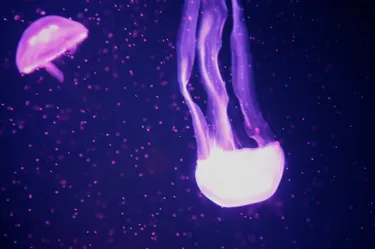Illuminating Creatures
- Sunday 17th September 2017

How and why some creatures glow is truly fascinating. Sadly, studying this phenomenon has proven difficult for marine biologists, making illuminating creatures seem even more mysterious and magical. Although many marine species glow, they don’t all glow in the same way and there are actually two main causes for this phenomenon; bioluminescence and bioflourescence.
Bioluminescence
Bioluminescence is when creatures actually emit light, either thanks to chemicals in their body, or to bacteria living on their skin.
For the creatures that glow because of chemical reactions within their bodies, the source of their wonderful glow is thanks to two substances called luciferin and luciferase. When these two substances combine to form a light-emitting compound. This type of reaction is similar to what happens when you crack a glow stick to light it up.
Research by marine biologists estimates that up to 90% of species living in the deep sea – thousands of meters down where sunlight can’t reach – are bioluminescent. Deep-sea fish in particular use this clever trick to attract prey and locate food, whereas glowing creatures in shallower waters use bioluminescence as a defense mechanism. Not much is known about bioluminescence in marine creatures as they lose their ability to glow when captured, making it difficult to study.
Bioluminescent creatures
- Clusterwink snails give off pulses of neon green light when threatened, and glow so brightly that the light shines through their shells. They also use their glowing slime to attract mates.
- Vampire squids are technically not squids or octopuses, but share characteristics with both. They use their bioluminescence to create intricate patterns in order to attract prey and disorientate predators.
- Atolla jellyfish are crimsoned-coloured predators that lurk in the deep sea. Their bioluminescence has earned them the nickname of “alarm jellyfish” because they emit a ring of bright blue light when attacked.
- Dinoflagellates are arguably the most magical looking out of all of the glowing creatures. They are a type of plankton and can light up entire beaches with their glow.
Bioflourescence
It’s estimated that over 180 species of fish and sharks are capable of bioflourescence. Unlike bioluminescence, bioflourescence isn’t a chemical reaction but the absorption and reemission of existing light. Creatures do this by absorbing blue light and emitting it as red, orange or green – all colours which travel well underwater and are a stark contrast to the usual blue hue of the sea.
What this means is that biofluorescence requires an external source of light, which means that only species that are exposed to sunlight can exhibit this trait – this is why deep sea creatures are bioluminescent rather than biofluorescent. According to marine biologists, this type of natural glow is used mainly for camouflage, communication and attracting mates.
Biofluorescent creatures
- Chain catsharks, or chain dogfish as they’re also known, exhibit different fluorescence patterns between the sexes. According to researchers, the most likely reason for this is to attract potential mates.
- Hawksbill turtles were the first reptiles recorded to have biofluorescent properties. Under blue light, they glow a brilliant green and red but scientists have yet to identify a reason for this as the turtles’ shells already provide adequate camouflage and protection from predators.
- Papuan scorpionfish blend in seamlessly with their environment, but when illuminated with blue or ultraviolet light, they grow a bright red colour.